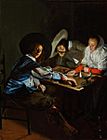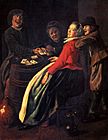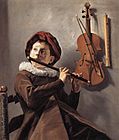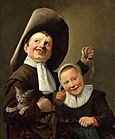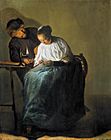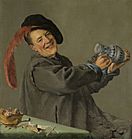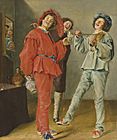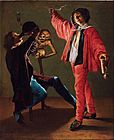Judith Leyster facts for kids
Quick facts for kids
Judith Leyster
|
|
|---|---|
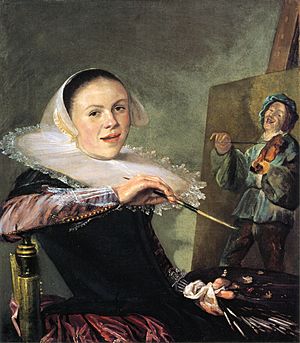
Self-Portrait, c. 1630, National Gallery of Art Washington
|
|
| Born | |
| Died | February 10, 1660 (aged 50) Heemstede, County of Holland, Dutch Republic
|
| Nationality | Dutch |
| Known for | Painting |
|
Notable work
|
The Proposition, 1631 |
| Spouse(s) |
Jan Miense Molenaer
(m. 1636) |
Judith Jans Leyster (born July 28, 1609 – died February 10, 1660) was a talented Dutch Golden Age painter. She created many different types of art, including scenes of everyday life (called genre works), portraits of people, and still lifes (paintings of objects).
During her lifetime, people really admired her work. But after she died, her art was mostly forgotten. Many of her paintings were even thought to be by famous male artists like Frans Hals or her husband, Jan Miense Molenaer. It wasn't until 1893 that people rediscovered her and started giving her credit for her own amazing paintings.
Contents
Judith Leyster's Life Story
Judith Leyster was born in Haarlem, a city in the Netherlands. Her father was a local brewer. She was the eighth child in her family. We don't know exactly how she learned to paint, but a poet from Haarlem, Samuel Ampzing, mentioned her in his book in 1628. This shows she was already known as an artist at a young age.
Some experts believe Judith started painting professionally to help her family. Her father had faced money problems. She might have learned from Frans Pietersz de Grebber, who ran a well-known art studio in Haarlem. Her family also moved to the province of Utrecht for a while. There, she might have met artists who were part of the Utrecht Caravaggism movement, known for their dramatic use of light and shadow.
Her first painting that we know she signed is from 1629. By 1633, she became a member of the Haarlem Guild of St. Luke. This was an important group for artists. Some say she was the first woman to join, while others say it was Sara van Baalbergen in 1631. Many women artists joined the Guild, but often their specific art form wasn't listed, or they joined to continue their deceased husbands' work.
Judith's painting called Self-Portrait (around 1633) might have been the piece she showed to the Guild to become a member. This painting is special because it shows a more relaxed and lively pose compared to earlier self-portraits by women. It's even similar to some of Frans Hals's work.
After joining the Guild, Judith took on three male students. This was unusual for a woman artist at the time! She even sued Frans Hals because he took one of her students without permission. The student's mother paid Judith some money, and Hals also had to pay a fine. Judith herself was fined for not registering the student with the Guild properly. After this lawsuit, Judith's paintings became even more recognized.
In 1636, Judith married Jan Miense Molenaer, who was also a painter. He painted similar subjects to her. They moved to Amsterdam hoping to find more work. They lived there for eleven years before moving back to Heemstede, near Haarlem. They even shared a studio in their home. Judith and Jan had five children, but only two lived to be adults.
Most of Judith's known paintings were made before she got married, between 1629 and 1635. We know of only a few pieces she painted after 1635. These include some drawings for a book about tulips from 1643, a portrait from 1652, and a still life from 1654. She might have also worked with her husband on some paintings. Judith Leyster died in 1660 when she was 50 years old. Her art was not widely known or recognized for almost 200 years after her death.
Judith Leyster's Artwork
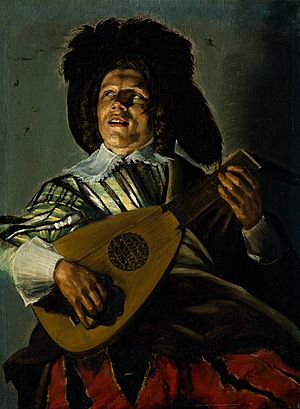
Judith Leyster signed her paintings with a special symbol: her initials "JL" with a star next to them. This was a clever play on words! In Dutch, "Leister" meant "Lead star," which was a common name for the North Star that sailors used to guide them. Her father's brewery in Haarlem was also called "The Leistar." Sometimes, she would sign her full name, but not often.
She was very good at painting scenes of everyday life that looked like portraits. These paintings usually showed one to three people, often looking happy, against a simple background. Many of her paintings featured children or men enjoying drinks. Judith was especially creative with her scenes of women at home. These were quiet moments, often lit by candles or lamps, showing things from a woman's point of view.
Many of her other works, especially those showing musicians, were similar to paintings by other artists of her time. These included her husband Molenaer, the brothers Frans and Dirck Hals, Jan Steen, and the Utrecht Caravaggisti artists like Hendrick Terbrugghen and Gerrit van Honthorst. Their paintings of taverns and entertainment scenes were popular with the growing middle class in the Netherlands. Judith painted very few actual portraits. Her only known history painting (a painting showing a story from history or myth) is David with the head of Goliath (1633).
In 1648, a Dutch writer named Theodore Schrevel praised her, saying: "There have also been many skilled women in painting who are still famous today, and who could compete with men. Among them, one stands out exceptionally, Judith Leyster, called 'the true Leading star in art.'"
Judith Leyster and Frans Hals
Even though Judith Leyster was well-known and respected when she was alive, she and her art were largely forgotten after she died. She was rediscovered in 1893. This happened when a painting that everyone thought was by Frans Hals was found to actually be hers! Sadly, some people criticized her work as showing the "weakness of the feminine hand," while many of her paintings were still given to Frans Hals.
The confusion, or perhaps even trickery, might have started during Judith's own lifetime. For example, in the 1600s, a man named Sir Luke Schaud bought one of Leyster's paintings, The Jolly Companions, thinking it was by Hals. This painting later ended up with an art dealer in London who called it one of the best Hals paintings. It was sold for a lot of money as a Hals.
In 1893, the Louvre museum found Judith Leyster's special star monogram hidden under a fake signature of Hals. It's not clear when the fake signature was added. When the real signature was found, the buyer sued the art firm that sold it to him. The case was settled, and the painting was kept, but it was clear that a Leyster had been sold as a Hals. Another version of The Jolly Companions had also been sold with Leyster's monogram changed to look like Hals's initials.
In 1893, an art historian named Cornelis Hofstede de Groot wrote the first article about Leyster. He said seven paintings were hers, and six of them had her unique star monogram. For a long time after that, some art historians still saw her as just copying or following Hals. However, this view started to change in the late 20th century.
We don't know exactly what kind of professional relationship Judith Leyster had with Frans Hals. She might have been his student, or perhaps they were just friendly artists who worked in the same city. Some historians think Hals or his brother Dirck might have taught Leyster because their paintings are quite similar.
Where to See Her Art
You can find Judith Leyster's paintings in many famous museums around the world. These include the Rijksmuseum Amsterdam; the Mauritshuis in The Hague; the Frans Hals Museum in Haarlem; the Louvre in Paris; the National Gallery in London; and the National Gallery of Art in Washington DC. In 2022, the Currier Museum of Art bought a Leyster painting to display alongside one by her husband, Jan Miense Molenaer.
In March 2021, Judith Leyster's work was added to the "Gallery of Honor" at the Rijksmuseum. She, along with Gesina ter Borch and Rachel Ruysch, are the first women artists to be included in this special gallery.
On December 19, 2022, Google celebrated her with a special Google Doodle in several countries, including the Netherlands, the United Kingdom, and the United States.
Gallery
-
The Jester, after Frans Hals
Images for kids
-
The Happy Couple by Leyster, 1630 (Louvre)
See also
- Maria de Grebber
- List of paintings by Judith Leyster
- List of paintings by Frans Hals
- In Spanish: Judith Leyster para niños




